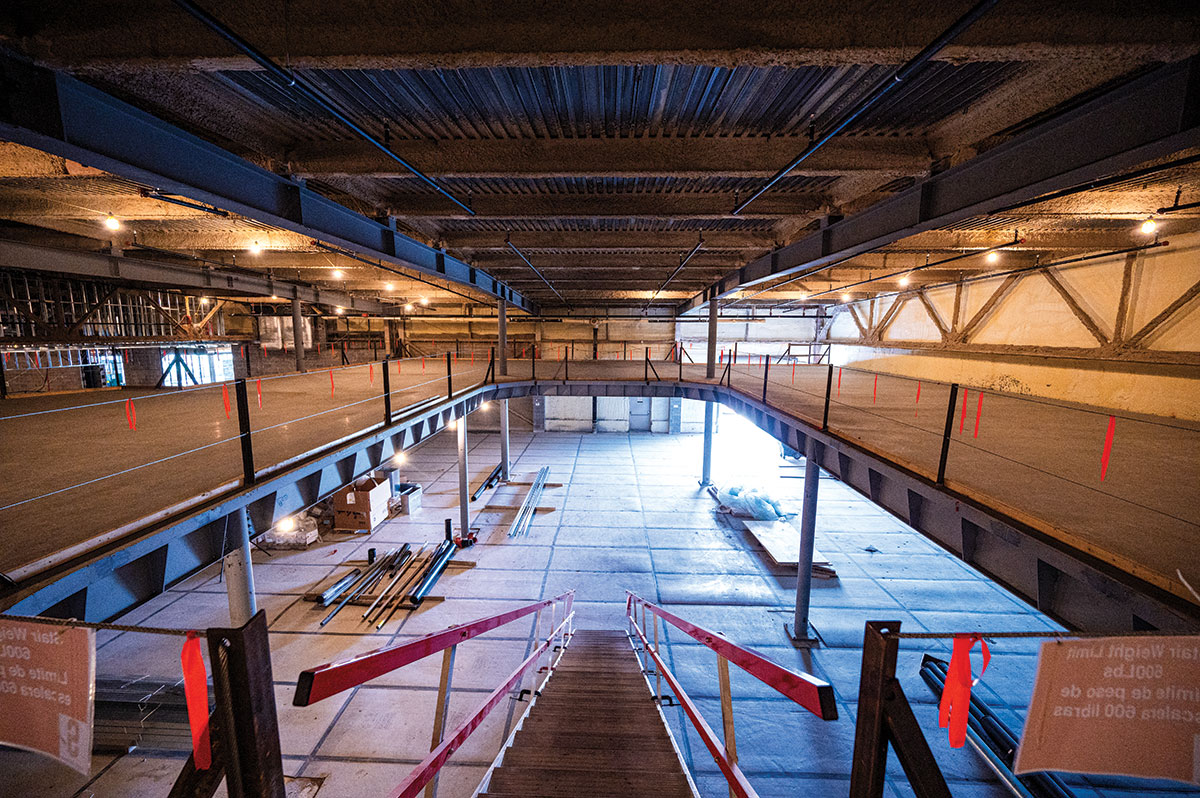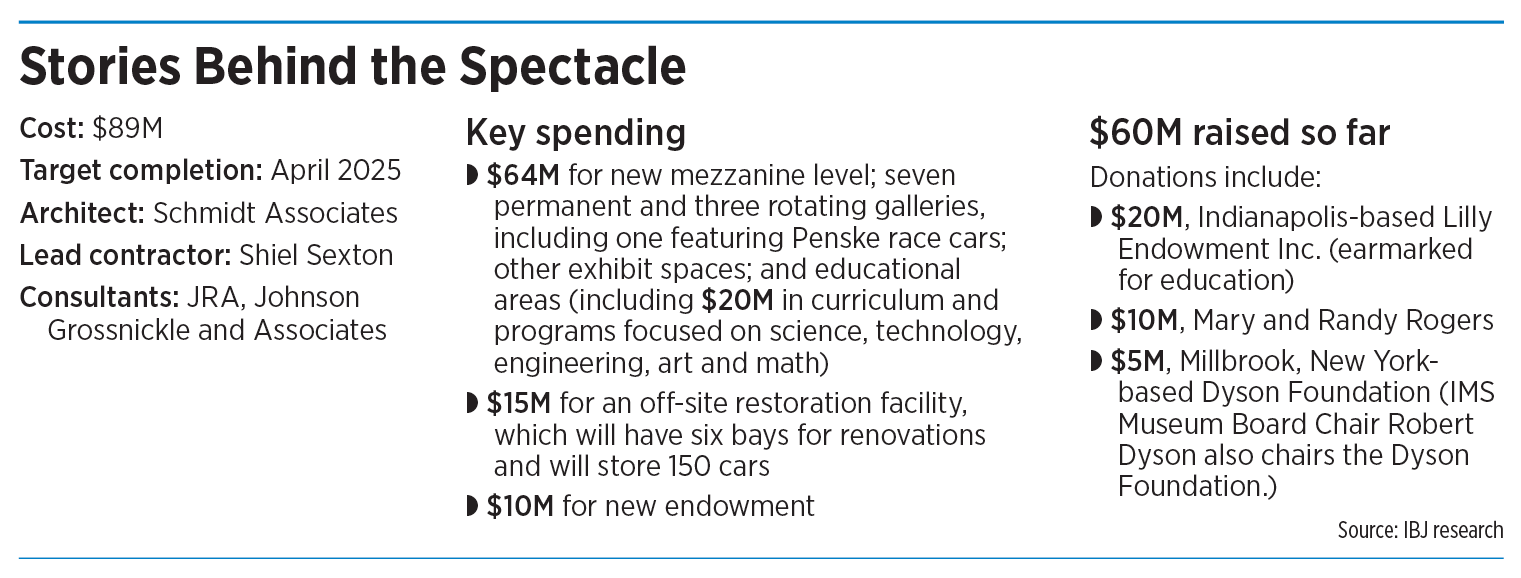Subscriber Benefit
As a subscriber you can listen to articles at work, in the car, or while you work out. Subscribe NowThe Indianapolis Motor Speedway Museum is amid a $64 million renovation to transform the 48-year-old building into a state-of-the-art facility that showcases the Indianapolis 500 and the evolution of IndyCar racing.
As part of that effort, the museum shut down last fall with plans to reopen ahead of the 2025 Indianapolis 500. Already, steel framework has been set in place for many of the exhibits, along with a mezzanine level and a car lift system to move vehicles between levels.
The museum announced an $89 million capital campaign in July to raise money for the project.
In addition to the $64 million for the renovation and educational programs at the museum building, the organization plans to put $10 million into an endowment and build a $15 million off-site restoration facility, although its location has not been made public.
The not-for-profit museum has raised $60 million for the effort so far. Penske Entertainment Corp., which owns the track, is not formally affiliated with the museum, although it owns the museum’s building, and Indianapolis Motor Speedway President Doug Boles serves on the museum’s board.
IBJ spoke with Joe Hale, president of the IMS Museum, about the efforts to remake the visiting experience and what is happening behind the scenes.
Let’s jump right into it. With improvements now underway at the IMS Museum, could you share the timeline on this project? How are things going so far?
After announcing our plans in July, we closed the museum on Nov. 5. We’re still operating tours around the track, but the museum building is closed with plans to reopen April 1, 2025.
It’s a complete renovation of the building, which we’ll get into more, but one of the challenges that we had with this is how we expand the museum without going outside of the footprint of the existing structure or building up. That was the charge we were given, and it’s been great working toward that so far.
Generally, what does this renovation consist of?
Our focus is always going to be on the Indianapolis 500—telling the stories, preserving the history and the stories of the 500—and that’s not going to change at all. But the way we tell those stories is going to change considerably. That’s one of the reasons that we chose this theme of “Stories Behind the Spectacle” for our campaign, because it’s all going to be about storytelling.
The moment you enter the museum’s Gasoline Alley, our visitors will see the development of technology and the evolution of design over the last 115 years. Then we have a starting-line gallery, where you can experience what it’s like to stand on the starting line on race morning, beginning with the cannon and ending with the “Drivers, start your engines” announcement. What this is all about … is to make it very experiential, not just entertaining. But we want to make it educational, as well.
That educational element is getting a $20 million injection from the Lilly Endowment, including a new classroom centered on science, technology, engineering, art and math. Why is it important that the museum has those educational offerings as part of the discourse it creates and the mission it’s serving?
Certainly, we are promoting the 500, and in some ways we’re a marketing arm for the 500. And one of our core efforts is ensuring the 500, that racing, continues and it continues to be the largest single-day sporting event in the world.
What we’re trying to do is build that next generation of folks that want to come in and learn about it, that want to participate in the next evolution of racing. Our educational program is about creating the generation of supporters of the race and the track.
This is the first renovation of the facility since it opened in 1976. What have been the biggest challenges in ensuring this renovation is done effectively and safely?
Well, we’ve already lucked out. The whole HVAC system basically died the week after we moved out, so we really dodged a bullet on that one and luckily, nobody was in the building. But it just proved how much maintenance had been deferred over the years—the windows were leaking, the fire suppression system was kind of shot, as was the HVAC, certainly, so we knew we had to do something.
But the biggest challenge was how to expand the museum without expanding the footprint. Shiel Sexton has been great to work with on that. And in working with them, we’ve been able to find ways that will allow us to do more exhibitions ourselves or … an exhibition at another facility that we can bring here. We’re looking for ways to give our visitors a reason to come back, and what’s the incentive to do that if we don’t have exhibits that evolve or switch around? So there’s going to be a lot changing in the new museum.
How have you been able to take inspiration from other museums, whether they’re focused on the automotive industry or other areas?
One of the things we’d do for the first few years in this process is, once a quarter, we’d all get in the van and we’d go to another facility, whether it’s the Kentucky Derby Museum or the Air Force Museum or the Henry Ford Museum. We tried to take a look at what was happening elsewhere and even here—we went to the Children’s Museum, the Indianapolis Zoo, Newfields—and looked at everything from the guest-experience perspective, starting from when you pull in the parking lot to the time you leave.
Another thing we’ve tried to keep in mind, too, is that 80% of our visitors come from outside of Indiana, and 20% of those folks come from outside of the United States. So it’s really a national and, in some ways, an international attraction—we’re a bucket-list destination for a lot of people. But we wanted to make sure that if you’re not a car person, you’re still going to find this place educational and entertaining. I think by continually changing out exhibitions and displays, that’s certainly going to help.
From a construction standpoint, what are the biggest hurdles that you still face in the buildout and completion of the reconfigured space?
Well, the hard stuff is done, and while I won’t say that it’s unrecognizable, it’s so vastly different from the moment you come in through the entryway.
One of the things we found from visiting other museums was that some spend millions of dollars on technology but found that we’re in front of a screen all day, so … maybe that’s not what people are looking for when they’re at a museum.
But now is when we need to start cementing things in terms of what those permanent exhibitions look like in terms of their displays, so we’re looking at that now to ensure we have the right balance.
What role have IMS owner Roger Penske and his company Penske Entertainment played in this undertaking by the museum?
They’re very supportive, and we’ve kept them informed every step of the way. IMS President Doug Boles is on our board, so we’ve got a great relationship with IMS and with the Penske organization, and they’re fully supportive of the direction we’re going.
Going back to our goal of preserving and telling the stories of the Indianapolis 500 and what’s happened at the speedway for the last 115 years, they’ve certainly made contributions there. There will also be a permanent gallery of Roger’s cars on display as part of the renovations, as well.
What can you share about the trials of fundraising for the project?
I think one of the challenges has been to help people understand that we are a separate organization from IMS, although it’s a very symbiotic relationship. But for us, being out there raising money to make sure the museum operates in a good manner has been somewhat of a challenge, but we’re really starting to get our story out there. We’ve been doing a lot more programming in the last three years, and we’re pushing forward.
Historically, IMS Museum wasn’t really part of the cultural conversation in Indianapolis, so one of the things we’ve been working very hard to do is join that conversation. So, we’re now talking about potential partnerships with other organizations when we do reopen, as we want to use this new museum in a very creative way.
That’s really kind of one of our objectives, especially while we’re closed now, to make sure that people understand the structure of our relationship to IMS and why essentially building this new museum now is so very important.
Does the museum see opportunities for naming rights with its galleries as part of an effort to drive donations?
From day one, that has been part of our strategy, and we have aggressively been doing that. Right now, there are naming opportunities in our museum that start at $10,000, and they go to $7.5 million. So, to answer the question, absolutely—any museum today has to look at that opportunity.
I probably spend part of every day looking at potential sponsorships; there’s a lot in each area of the museum, when you think about what is sponsorable, and we’re going after those.
The corporate and foundation communities in Indianapolis have already been very important and will continue to be. Because of the national stature of the Indy 500 and IMS, it does open some opportunities beyond the Indianapolis market, but I think we’ve really got to focus on Indianapolis.
As part of that, we’re going to really focus a lot of our programming, and certainly the museum, on increasing the number of central Indiana members and guests that we have. We want to really focus on the local population.
Are there any things that can’t be accomplished as part of this project that you’d like to revisit in the coming years?
You know, this is really kind of a dream come true, to be honest with you. If anything, we’re looking at, how do we expand outside the footprint out around the state and all around the country?
Are there classroom opportunities that we could provide, whether it’s to a fourth-grader or to a student in high school? We’re exploring it. And we’re looking at expanding beyond this footprint in a lot of ways by making parts of the collection available through loans to other facilities—we do that now, and we’re going to continue that.
Additionally, for a long time, when a child came into our museum, what they heard a lot was, “Don’t touch that, don’t touch that.” We want it to be a place where they can get involved and this is very interactive, so they can have experiences that they’re going to talk about for a long time.•
Please enable JavaScript to view this content.




Very professional approach. Can’t wait!